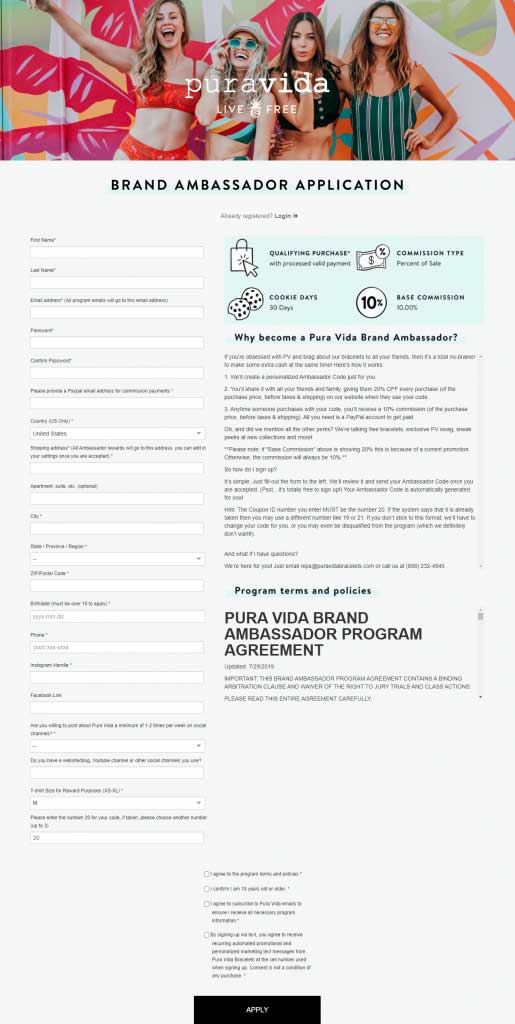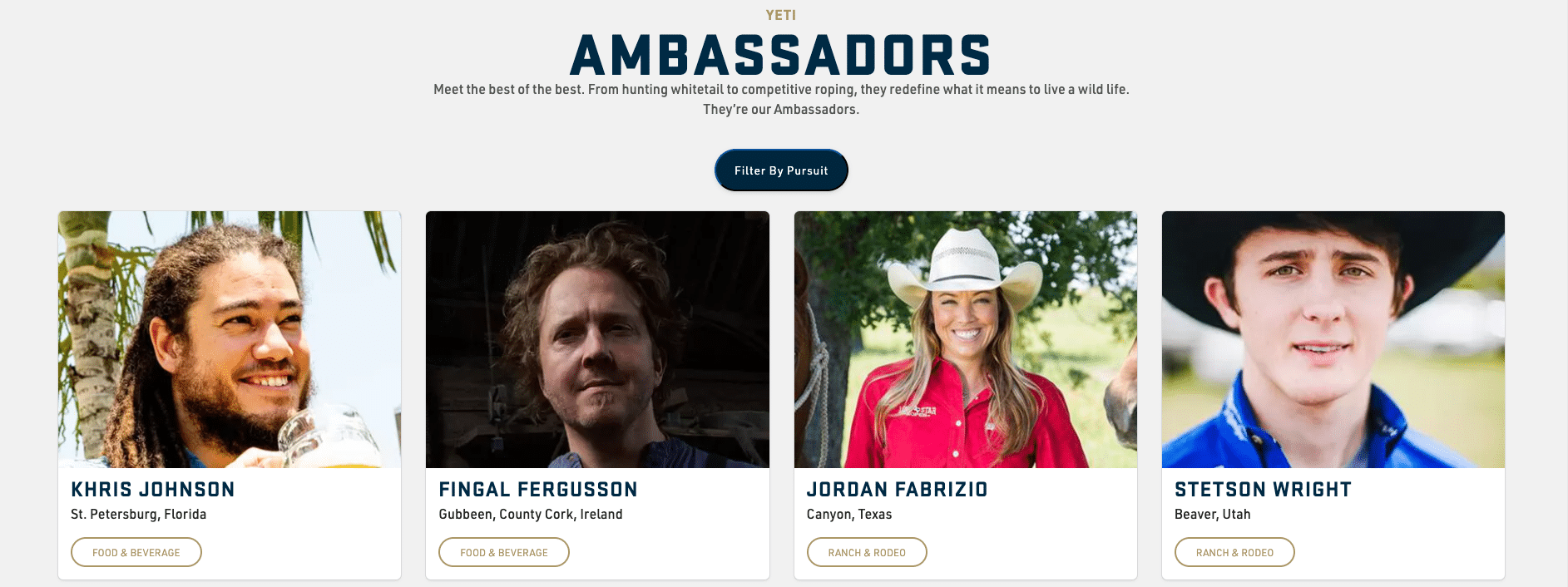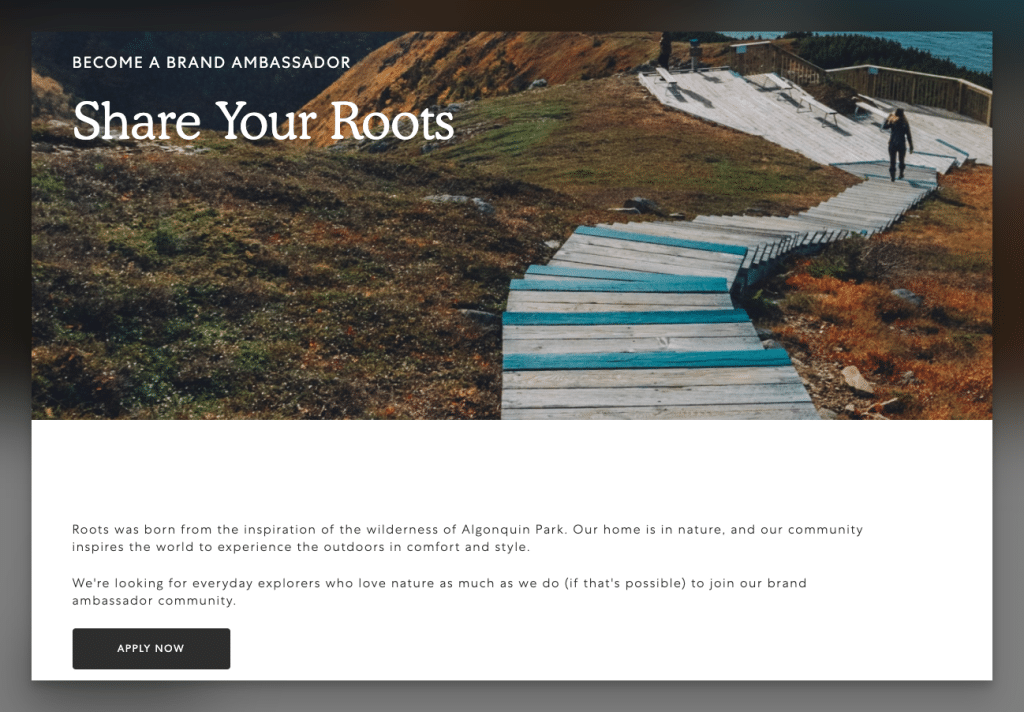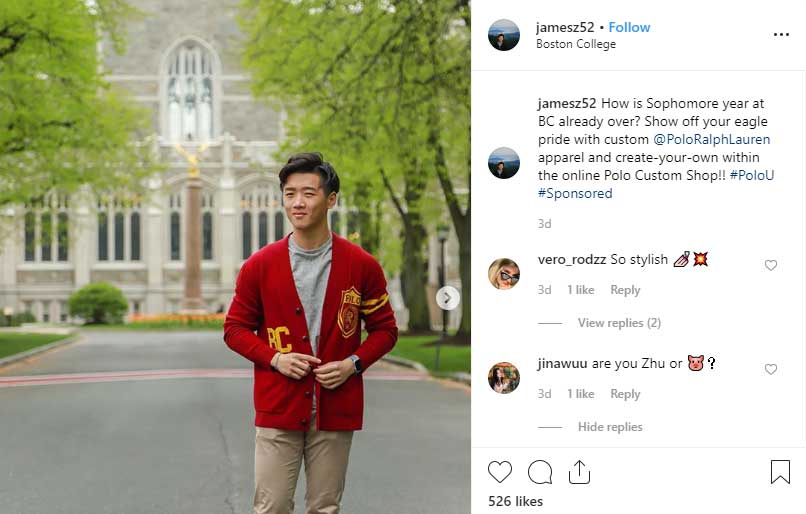Brand ambassador programs combine the virality of word-of-mouth marketing with the power of authority figures and influencers. Who wouldn’t want that?
But like all marketing campaigns, you’ll need a way to manage brand ambassadors and track their efforts. That’s where a formalized ambassador program comes in.
How to start a brand ambassador program of your own? We’ll help you determine whether an ambassador campaign will work for you — plus essential strategies for launching this type of program — in our step-by-step guide.
What is a brand ambassador program?
A brand ambassador program is a strategy where you form long-term partnerships with your biggest fans, who serve as authentic faces and voices of your brand.
Ambassadors could be your customers, partners, or employees. Regardless of their type, all brand ambassadors have an enthusiastic love for your brand and a desire to tell others about it.
Within your program, ambassadors will actively promote your brand to their networks, and help you generate leads, increase sales, and build brand awareness. This advocacy could happen online, offline, or both.
A brand ambassador program helps standardize the way your company works with individual brand advocates, including applications, referral tracking, and reward management.
How do brand ambassador programs work?
Ambassador programs involve:
- Finding loyal fans who are already sharing your brand, and who have influence in a niche or among an audience
- Recruiting these fans to promote you as your representatives
- Giving them the tools and guidance they need to promote your products/services
- Tracking and monitoring their online and offline marketing efforts
- Rewarding them for their hard work
The main purpose of a brand ambassador program is to enlist your biggest advocates — who align with your brand values — and achieve maximum marketing results from their influence and reach. Brand ambassador software will help you track and scale your program for optimal results.
What will brand ambassadors accomplish?
Depending on your brand’s goals and the skillset of your ambassadors, you might have your ambassadors promote your brand in any of the following ways:
- Posting how they authentically use your products in their daily life, on social media or on their blogs (most common!)
- Representing your brand at offline events, such as trade shows
- Organizing events and/or guerrilla marketing pop-ups of their own, to showcase your products
- Engaging with current and potential customers online and offline, to build relationships and answer questions
But all ambassadors will promote your brand authentically, regularly, and for an extended period.
Benefits of brand ambassador programs
Here are seven reasons your business should create a brand ambassador program:
1. Brand ambassadors are trusted.
92% of consumers believe recommendations from family and friends far more than direct messaging from a brand. Recommendations that come from personal experience, such as with brand ambassadors, are one of the most trusted sources of information. If you want to tap into a new target market, the right brand ambassadors can help you do so in the quickest way possible.
2. Brand ambassadors promote your products authentically.
Since ambassadors have already used your products, they can use their own perspective and words when sharing your brand. Their promotions are far more effective than typical sales pitches.
Brand ambassadors may even promote your products without prompting (because they genuinely love your brand). It’s this real, powerful testimony that leads to more purchasing decisions.
3. Brand ambassadors create and share content for you.
Whether it’s a social media post, a blog article, or a glowing review, ambassadors create content that shines the spotlight on your brand.
As long as you furnish ambassadors with your latest products and information, you can sit back as they roll out fresh content in their own distinct style.
This unique, user-generated content is posted and shared widely throughout their network. You can also repost the content on your own site and channels.
4. Brand ambassadors expand your reach.
Regardless of their audience size, a brand ambassador is in a great position to expand your market share – as long as their audience demographics match your brand’s audience.
As long as your ambassador’s audience engages with their content regularly and trusts it, you have the makings of a word-of-mouth campaign and a community you may not be able to access on your own.
5. Brand ambassadors offer great feedback.
Brand ambassadors are already fans of your product – which makes them great testers. They’ll share what they love, as well as what they think you can improve on. This honest feedback helps iron out any rough spots before launching a new product to the general public.
6. A formalized program keeps ambassadors in the loop.
Creating a brand ambassador program helps keep your ambassador relationship running smoothly. A program formalizes all the details of the relationship, including any requirements, guidelines, and incentives that have been agreed on.
7. It’s cost-effective to set up a brand ambassador program.
Even if you decide to reward your ambassadors with store credit or discounts, brand ambassador programs are still one of the most cost-effective marketing strategies. Any payments are based on results, meaning you only incur costs after you make a new sale or meet another goal.
Who should set up a brand ambassador program?
Ambassadors are a great addition to any marketing strategy, but managing a brand ambassador program does require work. Some businesses may be more prepared to handle these types of programs. Here are a few signs your business is ready to start a brand ambassador program:
- You’re confident in your products and services. The best brand ambassadors already use your products and are eager to share them with their audience. Before you start a formal brand ambassador program, make sure your products are the highest quality possible.
- You have a happy customer base (and some are already sharing your product!), Having happy and loyal customers shows you’re doing something right – and others need to hear about it. In fact, many ambassadors start out as loyal customers who have shared your product with others, without you even asking. (Hint: These are the customers who you should look at when creating your brand ambassador program.)
- You have the resources to create strong marketing campaigns. A brand ambassador program isn’t a replacement for your entire marketing strategy. While ambassador programs are a great source of UGC content and promotions, brand ambassadors still need something to share. It’s important to maintain a lineup of engaging campaigns, and work with your ambassadors to maximize exposure.
- You’re active on the right social media channels. Be present on the same platforms ambassadors are, so they can direct viewers to your business account, and so you can directly engage and answer any audience questions.
Furthermore, brand ambassador programs are highly recommended if your business also meets the following:
- You’re in a highly competitive industry. Even with the best products, it can be difficult to stand out in a highly competitive industry where it’s hard to differentiate yourself. Affiliating yourself with an expert or notable personality can give you that edge you need. Brand ambassadors can help make your product stand out from competitors, thanks to their unique perspective and content.
- You sell physical products. Ambassadors make more sense for brands that sell physical products like clothing, equipment, or housewares. This isn’t a hard and fast rule, though — the software company Notion has an ambassador program, but requires ambassadors to “teach and share Notion with others.”
- You’re targeting a niche audience. In smaller niches, there are usually a few prominent individuals who stand out and audiences follow. These are the individuals to invite to your brand ambassador program.
How to start a brand ambassador program in 6 steps
Starting a brand ambassador program may seem daunting, but it doesn’t have to be. In fact, if you have happy customers cheering for you, you’re already off to a good start.
How to create a brand ambassador program? Follow these six key steps:
- Set goals for your program
- Define your ideal brand ambassador
- Determine program criteria and guidelines
- Find and reach out to potential brand ambassadors
- Reward and recognize your brand ambassadors
- Track the progress of your program
Let’s cover the details you’ll need to implement the six steps.
1. Set goals for your brand ambassador program
Before you start reaching out to potential brand ambassadors, it’s important to create clearly defined program goals. This helps set your expectations and requirements from each brand ambassador.
While goals differ for every business, knowing what you hope to achieve makes it easier to gauge whether or not your brand ambassador program is successful. Here are a few common goals to draw from:
- Increase brand awareness and brand recognition
- Drive sales
- Generate conversions
- Expand to new audiences
- Build a large social media following
- Foster customer loyalty
- Create a sense of community around your brand/products
2. Define your ideal brand ambassador
Now, it’s time to determine what you’re looking for in a brand ambassador.
Aside from showing a passion for your brand, brand ambassadors can be almost anyone – loyal customers, employees, industry experts, etc.
Most brand ambassadors fit at least one of these categories.
The enthusiast: People who are very enthusiastic about your brand make excellent ambassadors. Not only do these fans already love your products and services, their passion comes through their promotion.
The niche expert: The expertise of these brand ambassadors increases the odds of someone trusting their recommendations.
- An athlete promoting a running shoe company and a dermatologist promoting a new skincare line are two examples of niche authorities.
- Expert ambassadors are perfect if you’re in a highly specialized field, such as medicine or B2B SaaS.
The peer: Peers are great brand ambassadors as they can easily reach your target audience. Not only are they more approachable and friendly, a majority of consumers trust peer recommendations more than any other source.
- For example, if your brand is geared toward college students, it might help to recruit brand ambassadors on campus.
- Or, if your company makes plant-based food products, it makes sense to team up with nutritionists or vegan chefs (or even impressed foodies).
The celebrity: Celebrity brand ambassadors are famous, recognizable people (at least in their niche) with a large following and the ability to influence trends.
- Just one mention from a celebrity brand ambassador can get you in front of a massive audience.
- However, a lot of celebrity content can be seen as superficial, so be careful when choosing celebrity brand ambassadors.
3. Determine program criteria and guidelines
Adding structure to your brand ambassador program shows potential ambassadors you value their work and want to build a beneficial long-term relationship. Depending on the type of brand ambassador you choose, you may want to establish criteria and guidelines for how they will promote your brand. Here are some points to get you started:
| Ambassador Criteria | Guidelines / Expectations |
|
|
4. Find and reach out to potential brand ambassadors
The best brand ambassadors are carefully handpicked, which makes this step a little different compared to, say, a referral program or affiliate program.
A good start to identifying your ideal brand ambassadors is to look at where your target market spends their time.
- What platforms are they on?
- Who do they listen to?
- Do these individuals meet your brand ambassador requirements?
There are many ways to find brand ambassadors. Here are six of the best ones:
Social media searches
This is relatively simple in principle, but can be time-consuming.
If you already know of people who have posted about your brand, they are a good place to start.
If not, search through your top social media platforms for any posts that have tagged you or include your brand hashtag. This requires some discernment – not everyone who uses your hashtag is a good fit to be a brand ambassador.
Software programs
Fortunately, there are amazing software programs to help you find your perfect brand ambassador. Instead of spending hours manually tracking mentions of your brand, a simple tool can do all the hard work for you.
Brand mention tools reveal who is talking about you, allowing you to filter through any mentions of your brand or products on select platforms.
Once you’ve found some potential ambassadors, a full-fledged brand ambassador software can also help you reach out to them and manage your entire program.
Referral Rock’s referral and brand ambassador software is flexible enough to run all types of partner programs.
Learn more about how we can help you track and grow word-of-mouth with an ambassador program.
Customer data
Another way to identify brand ambassador candidates is to look at your own customer data.
- Who are your most loyal customers? Who buys from you most often?
- Loyalty is a strong sign someone might be a strong brand ambassador.
- A good idea is to check your own customer data first, and then search social media for any brand mentions from the loyal customers you’ve identified.
- After all, it’s important for a brand ambassador to be an active promoter, as well as a loyal customer.
Influencer marketing platforms
Thanks to the rise of brand ambassadors and influencers, there is a corresponding crop of influencer marketing platforms. While these platforms are built for influencer marketing, they can also be used to find the right ambassadors.
Influencer marketing platforms do a lot of the legwork for you. They pool together a pre-vetted database and in-depth data, analyzing metrics like follower size, engagement rates, audience reach and interests, and more. Simply set filters according to your preferences and the platform will reveal your top matches.
Formal application forms
You can also employ traditional methods to promote your program. A common example is publishing a brand ambassador application form and letting potential ambassadors come to you. You can add the form (or a link to the form) in targeted emails, post-sales messaging, and other pages customers visit on your website.
- In the application form, ask why the customer bought your product and reasons why they love your brand.
- Also, ask if they’d be willing to consistently share your products with their network.
The submitted answers help you determine the customer’s viability as a brand ambassador, and give you an idea of the voice of their personal content.
The benefit of an application form is that only really interested parties will fill it out. Add a web application toward the end of your selection process, helping you narrow down the list of your best candidates.
Informal application process
The same application process can be used to run a brand ambassador program that’s more informal. Similar to a referral program, this type of application process invites anyone (or almost anyone) who loves your brand to join.
- Customers sign up to become brand ambassadors via a simple form on your website.
- They’ll receive a code or link to share with their friends and followers.
- Whenever someone uses that link to make a purchase from you, that particular ambassador will earn an incentive.
Even with an informal application process, you should still personally reach out to customers and let them know about your ambassador program.
- You can run an informal ambassador program for all your customers, while inviting your best customers (or best-performing informal ambassadors) to join your formal ambassador program.
- Just make sure to offer formal ambassadors bigger perks to reflect their long-term commitment to your brand (more on incentives below).
Pura Vida’s brand ambassador application form
Once you’ve identified some brand ambassador candidates, start forming relationships with them.
- Follow their social media accounts (especially on the platforms you want them to post on).
- Comment on some of their posts.
- Read how they engage with their followers.
- If you want, you can also repost some of their content and see if it resonates with your own brand followers.
Then, after you’ve found the most suitable candidates, it’s time for outreach. Invite them to be part of the program and outline what they can expect.
5. Reward and recognize your brand ambassadors
You’ve signed on the first ambassadors for your program – congratulations! Now, how to run an ambassador program that drives results?
Keep your ambassadors motivated and committed to promoting your brand with the right rewards. While some ambassadors are fine promoting your brand for free, rewards are a nice way to show how much you value the ambassador’s effort and create a win-win.
Rewards don’t have to be expensive or even monetary.
According to Maria Cuasay, who helped create referral programs for Lyft and Opencare, the “importance of incentives is really to catch someone’s attention.”
While cash obviously attracts attention, other incentives like store credit, gift cards, freebies, and other items of value can work just as well.
Think about what motivates your potential brand ambassadors, and offer these as a token of thanks for their support. Make sure you inform ambassadors when they will receive their rewards – after each post, every month, every quarter, etc.
In addition to rewards, recognizing a brand ambassador’s achievements is an important part of making them feel valued and part of your team. Here are a few ways to show your appreciation:
- A personal thank you note
- A special feature on your website
- An “ambassador of the month” series promoted on your social channels and blog
- A shoutout on Instagram Stories
You can also ask them about their experience with your brand and share what makes them a stand-out ambassador. This is a great way to personalize your ambassador shoutouts, and highlight your brand ambassador program in the process. And offering discount codes that ambassadors can share with their audience doesn’t hurt either.
Referral Rock software is flexible enough to handle any type of rewards, including tiered rewards and timed incentives. Here’s more on how Referral Rock can help you manage ambassador rewards >
6. Track the progress of your brand ambassador program
With your brand ambassador program up and running, you’ll find there are a lot of things to keep track of. Every brand ambassador, each time they promote your brand, and all the engagement and feedback that comes from each promotion.
Don’t let all this data go untracked. Once you (and your ambassadors) agree on what will be tracked throughout your program, it’s best to use a software analytics tool to bring all this data together. Here are some important metrics to track:
- Frequency of posts (blog posts and social media posts)
- Impressions and engagements
- Reposts and shares
- Brand reach and inbound traffic
- Issued rewards
In Referral Rock, you can track shares by member from the Member Visits dashboard and track the total number of shares your program is generating (alongside converted referrals, for example).
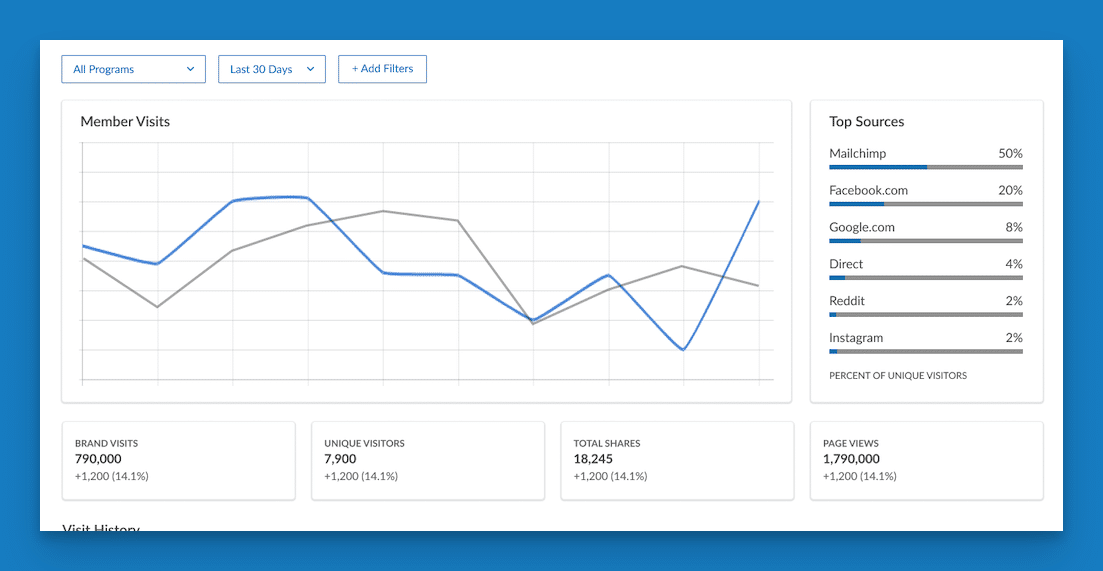
In addition to tracking metrics in real time, a brand ambassador tool can also be used to communicate with your ambassadors and manage key elements of your program (e.g. rewards tracking and management).
What are some tips for building ambassador relationships?
As with any long-term relationship, you can’t just reach out to ambassadors once and leave it at that. It takes continuous work and care to maintain a successful ambassador program.
Here are a few best practices and tips for building a brand ambassador relationship that lasts:
- Provide onboarding: Even your best customers should be briefed on your brand ambassador guidelines. Whether this is through a 1-on-1, email drip campaign, or webinar series, make sure you cover all the details of the relationship before promotions begin.
- Be available: Make sure brand ambassadors can easily reach you with any questions or suggestions, and respond within a reasonable time frame.
- Send regular updates: Are you starting new marketing campaigns? Planning new product launches? Updating your messaging? Let your brand ambassadors know. Regular updates are necessary for brand ambassadors to promote fresh content to their followers. These updates also excite ambassadors and create more reasons for them to share your brand with their audience.
- Create a newsletter or community: You can also create a newsletter especially for your brand ambassadors – or an exclusive online community – with promotion reminders and best practices. This is a great way to equip your brand ambassadors with insider information, and emphasize the exclusivity of the program.
- Encourage ambassadors to express themselves: The purpose of a brand ambassador program is to spread the word about your company through your ambassador, using their social media marketing, their website, presence at events, and other networking. Aside from following basic brand guidelines, ambassadors should always promote your brand authentically and in their own voice.
- Ask for ambassador feedback: Ambassadors want to see your brand succeed. As a member of your target market, they can offer fresh perspectives to help your campaign resonate with others. Ambassadors can even test out new products and provide in-depth feedback before you launch to the public.
- And give them feedback in return: In the same way you recognize ambassadors for their success, you should also offer constructive feedback. As long as you don’t stifle their creative control, feel free to suggest ways they can better promote your brand.
- Keep constant communication: Don’t be afraid to ask for check-ins or updates from each individual ambassador (within reason, of course). You can schedule these regularly with individuals or as a group.
- Refresh your program (using data): Through time, your brand, your ambassadors, and your audience will change – your brand ambassador program should change, as well! Look at all the data you’ve tracked to see what resonates best with your audience and brings in more customers. Then, adjust your program to double down on these efforts.
Why you need brand ambassador software
To run a successful brand ambassador program, you’ll need brand ambassador software. The best brand ambassador software enables you to track the brand awareness and sales your ambassadors help you make, by giving every ambassador a unique link to your website.
Referral Rock brand ambassador software tracks detailed metrics from your program, so you and your ambassadors know how the program is performing at a glance. And every time ambassadors drive a sale (or bring in a qualified lead), our software can automatically issue rewards to thank them for their promotions.
Our software helps you smoothly communicate with ambassadors by providing them status updates on their referrals and automating emails to keep the program fresh in their minds. Plus, thanks to our One Click Access links, it’s easy for ambassadors to access their sharing portal whenever they want, with no password needed.
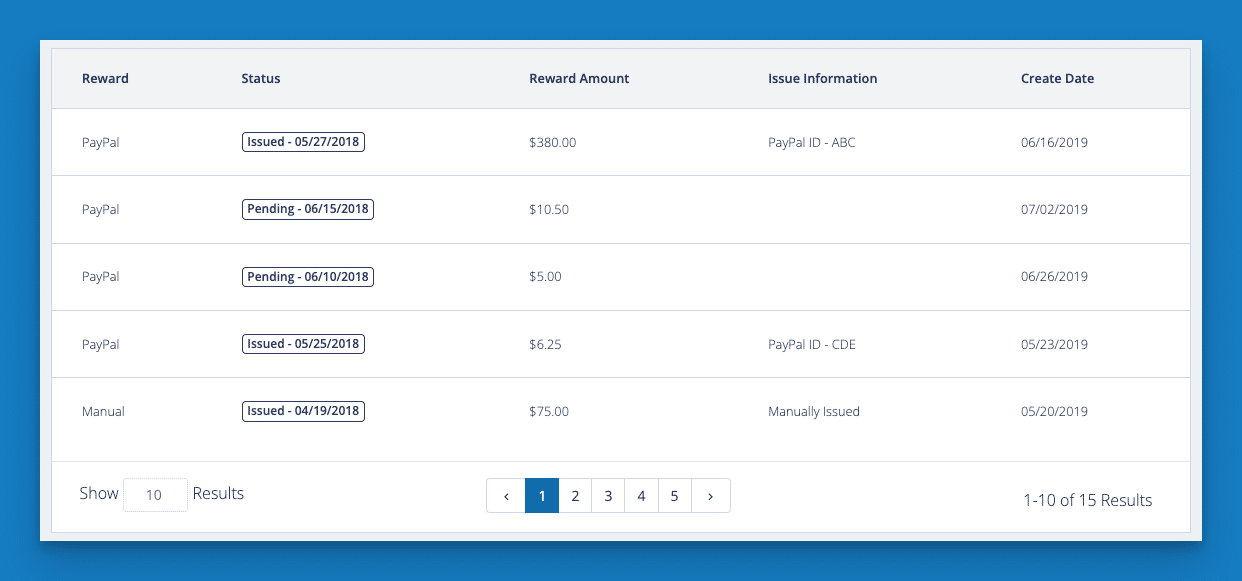
What are the types of brand ambassador programs?
Do you think your business will benefit from a brand ambassador? There are six types of brand ambassador programs to choose from:
1. Requirement-driven or invite-only brand ambassador programs
This is what many marketers consider to be an official brand ambassador program.
In a requirement-driven program, an ambassador must complete certain requirements on behalf of a brand within a specific time frame – say, 10 social media posts a month, or five brand mentions on their personal blog.
- This type of ambassadorship is very versatile and gives you direct control over your budget.
- Plus, brands can use requirement-driven promotions across any industry, and can easily refresh the requirements to fit their overall marketing strategy.
An invite-only program is where a brand selects ambassadors to be in its program (there’s no open application) — this is usually more common for bigger brands, like Yeti (a brand known for its drinkware and coolers).
2. Affiliate brand ambassador programs
Building on the marketing efforts of brand ambassadors, this type of affiliate program aims to ultimately generate purchases.
- Affiliate brand ambassadors promote products and services on their own platforms (usually social media and personal websites), including a unique affiliate link that attributes the sale back to them.
- In exchange, they receive a commission for every completed purchase.
- It’s common to offer tiered incentives – the more sales an affiliate brand ambassador drives, the higher their commission percentage.
3. Informal brand ambassador programs
Informal brand ambassador programs are open to anyone who loves your brand.
With this type of program, there are no signed agreements or requirements. Oftentimes, there are no rewards, although some brands offer special incentives to their top-performing ambassadors.
An informal brand ambassador program is great for generating word of mouth and referrals. But without any guidance or structure, it can be hard to track and optimize where your new customers are coming from.
4. Employee ambassador programs
Your employees already know what sets your brand apart, are familiar with your products or services, and are committed to your company values. Why not use this to your advantage and recruit employees as your ambassadors?
If you choose to start an employee ambassador program, give your employees the freedom to use their own voice and methods to promote you (as you should with any other ambassador). This will ensure that they are authentic in their promotions.
5. Customer ambassador programs
Customer ambassador programs tap into your customers’ genuine love for your brand, and equip them to authentically promote it to people who trust them.
These programs can be formal (where your company handpicks select ambassadors and trains them to promote you in the long term) or informal (where any customer can join and share your brand with others).
6. College brand ambassador programs
Colleges and universities provide the perfect setting for starting a brand ambassador program – a massive number of students, with natural groupings by interest, sport, or hobby.
College brand ambassadors have a strong, active social media presence. They can also share your brand through word of mouth and guerilla marketing tactics (i.e., sticker bombs, branded outfits, product handouts).
Although this type of brand ambassador program focuses on the 18-25 age bracket, it allows for a lot of fun promotional potential. Plus, college students are eager to gain practical experience and will often promote your brand in exchange for free products and skill development.
James Zhu is a Polo Ralph Lauren campus ambassador at Boston College.
Are brand ambassadors different from influencers?
Brand ambassadors and influencers are both representatives that companies select to promote a brand. But there are several differences between these two types of partnerships.
Brand ambassador program relationships are generally more long-term than influencer campaigns. While influencers will only promote you in one social post or one short campaign, ambassadors will usually promote you for a year or more.
And while influencers haven’t necessarily used your brand before you partner with them, brand ambassadors are always people who have used and loved your products or services.
You’ll usually select ambassadors based on how much they love your product and how skilled they are in relationship-building, in addition to their authority in a niche or among an audience. Meanwhile, influencers are usually selected solely for their influence over a given audience.
Another difference is that influencer partnerships are always formal. An influencer is invited to promote a brand through a campaign and is paid for their efforts.
Like influencer programs, traditional brand ambassador programs are also invite-only. Some brands, however, let any customer join their ambassador program, or hold contests to find their next brand ambassadors.
What are some successful brand ambassador program examples?
Now that you know the basics of building a brand ambassador program, it’s time to get inspired by three brands that know how to run an ambassador program following best practices. Let’s review a few notable brand ambassador program examples:
1. Lululemon
Lululemon was one of the first brands to recruit long-term ambassadors – and their brand ambassador program is still going strong.
The goal of Lululemon’s ambassador program is to provide feedback about the brand’s product and help with social impact programs. It also encourages autonomy and personal growth, for both its employees and consumers.
For this reason, the program is built to include two types of ambassadors: Global Ambassadors and Store Ambassadors. Each ambassador is selected because they reflect the Lululemon culture and today, the brand has a mix of partnerships with local ambassadors and influencers, alongside elite athletes and fitness gurus.
2. Red Bull
Red Bull’s Student Marketeer is the perfect example of a college brand ambassador program. The company has “4,000 student marketeers around the globe generating awareness and excitement for the product and brand.”
Red Bull presents its brand ambassador program as a professional career. Depending on their skillset, ambassadors are assigned to mobilize campus campaigns or even an entire region. Student marketeers are in direct contact with customers, support the company’s sales teams, work with renowned athletes, and are invited to product trials.
3. Bumble
Bumble knows exactly what it wants in an ambassador, and has built two tailored brand ambassador programs to target distinct parts of its market. The first, Bumble Honeys, is a student ambassador program, while the second, Queen Bees, recruits young professional women with expertise in networking.
Both Honeys and Queen Bees generate creative ideas that resonate with Bumble’s audience, host events, form partnerships, organize guerilla marketing stunts, collaborate with influential authorities, and work closely with leaders at Bumble’s headquarters.
In the process, Bumble’s brand ambassadors are able to grow their professional network, cultivate their leadership skills, build their resumes, and take advantage of unique, fun opportunities while furthering their career.
Wrapping up
Brand ambassadors are experts at word-of-mouth sharing and building trust with an audience. Plus, they’re already passionate about seeing your brand succeed. Why not take the relationship to the next level and invite them to your brand ambassador program? Be sure to incentivize ambassadors to show your appreciation, and track your program’s ROI so you know whether it’s successful.
If you’re looking for brand ambassador software, learn more about how Referral Rock can help you grow word of mouth with a dedicated ambassador marketing solution. It’s flexible enough to help you build and manage customer referral programs, affiliate programs, ambassador programs, and partner programs.



